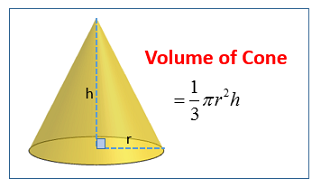How do you find the density of a cone of radius #"5 cm"# and height #"2 cm"# if its mass is equal to #"6 g"# and its volume is equal to #"52.36 cm"^3# ?
1 Answer
Here's what I got.
Explanation:
Start by calculating the volume of the cone.

In your case, you have
#r = "5 cm" -># the radius of the cone#h = "2 cm" -># the height of the cone
Plug your values into the equation to get
#V = 1/3 * pi * "5 cm"^2 * "2 cm"#
#V = "52.36 cm"^3#
Now, to find the density of the material, you must determine the mass of exactly
#1 color(red)(cancel(color(black)("cm"^3))) * "6 g"/(52.36 color(red)(cancel(color(black)("cm"^3)))) = "0.1146 g"#
Since this represents the mass of exactly
#color(darkgreen)(ul(color(black)("density = 0.1 g cm"^(-3)))#
The answer is rounded to one significant figure.
SIDE NOTE This is a very low value for the density of a material, so make sure to double-check the values given to you for the mass of the cone and for its dimensions.

